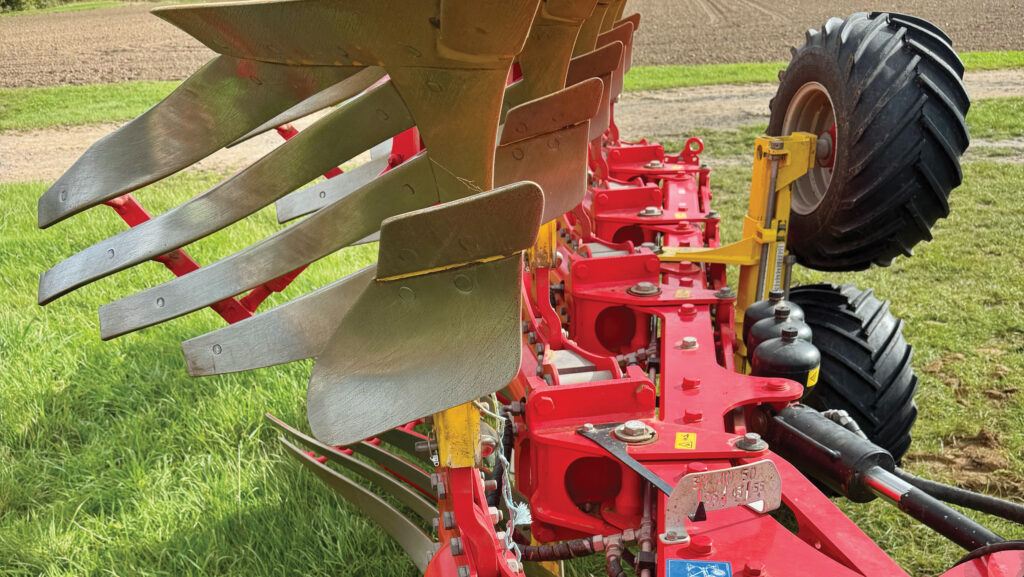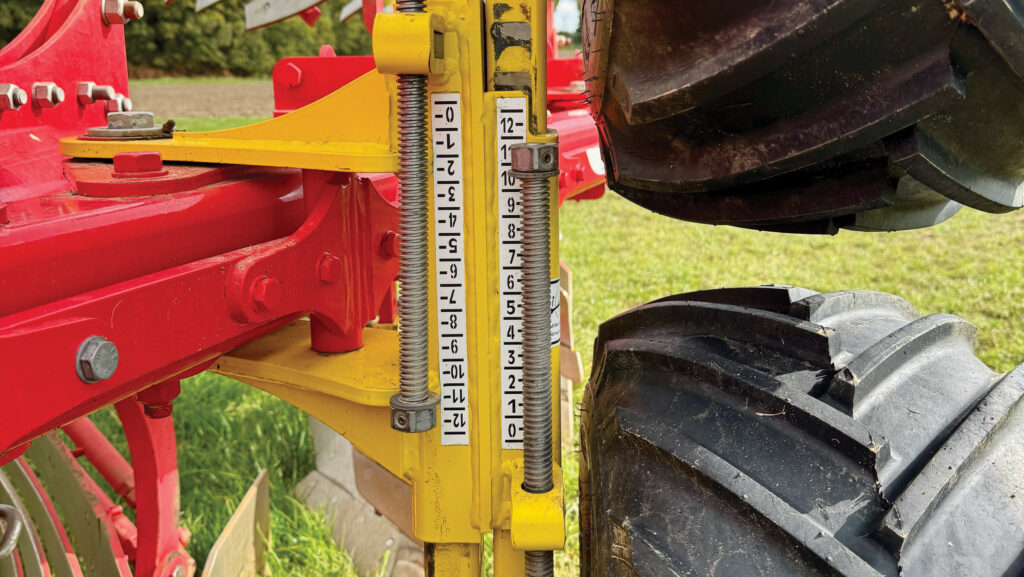On test: Pottinger’s revamped Servo 3000 plough
 © MAG/Oliver Mark
© MAG/Oliver Mark Whisper it, but plough makers could be set for better times, if one Essex grower’s recent experiences are anything to go by.
As reported in Farmers Weekly, direct drilling zealot Simon Cowell’s reward for trialling a return to rotational soil inversion was a 1.7t/ha uplift in wheat yields.
Crop performance had previously stagnated despite improvements in soil structure and biological activity.
See also: First impressions: Kuhn Multi-Master L six-furrow plough
This revelation no doubt saw kindred spirits spit out their tea, but the gains are in the grains, and the extra loads off the combine more than offset the costs associated with turning over the heavy clay at Motts Farm.
Simon’s experiment, though small-scale and short-term, suggests warming sentiment towards agriculture’s oldest art form, especially among those partially rowing back from single-pass establishment by reintroducing some rotational soil inversion.
Fortunately, manufacturers are primed for any potential semi-resurgence, with Kverneland, Kuhn, Lemken and Austrian firm Pottinger having all miraculously found further ways to hone this age-old implement.
For the latter, this includes the Servo range unveiled two years ago.
We’re focusing on the three- to six-furrow Servo 3000, seen here in five-furrow guise with a 240hp-rated headstock.
This sits between the lightweight 2000s (three or four furrows, 130hp) and 4000s (four to six furrows, 360hp) in Pottinger’s mounted range.
Beyond them comes the semi-mounted 6000-series.
Pottinger Servo 3000 Nova Plus as tested
- Bodies Five
- Protection Hydraulic auto reset
- Point-to-point clearance 88cm
- Furrow width 28-46cm
- Underbeam clearance 74cm
- Weight 1,900kg
- List price £42,720
- Notable options Hydraulic vari-width (£3,910), hydraulic front furrow (£1,018)
Stronger frame

© MAG/Oliver Mark
The evolution from Servo 35 to Servo 3000 saw the introduction of a stronger 120x120mm beam, beefed up with the use of chunkier 10mm-thick box steel.
This has an extended support section, now stretching to the third furrow, and a new internal reinforcement bar – both of which help absorb and distribute the bending forces afflicted on the main beam.
It also ensures Pottinger’s reputation for building heavy-duty ploughs lives on – feeble-but-functional leg stand aside.
The five-furrow version weighs 1.9t, a figure that could quickly rise with the addition of cutting discs and the like.
To ease the burden on tractors with limited lift capacity, the firm has introduced a new 88cm point-to-point clearance option as an alternative to the more common 95cm and longer-still 102cm setups.
This compact arrangement undoubtedly makes the plough more manageable.
But there is a compromise: less space between each body leaves little time for furrow-bound trash to land before the next one passes through.
Speed is the determining factor on the consistency of stubble burial.
Push on too fast and the occasional clump will be flung over the mouldboard in front and left on the soil surface – particularly when the plough is narrowed up.
Pick your body
As ever, performance will, to a large degree, be dictated by the buyer’s choice of metal.
We had the firm’s slatted mouldboards (+£387/furrow), and there was much to enjoy about the crumbling job they did in this year’s dreamy conditions.
The splay of the slats should also work favourably in stony stuff.
At the other end of the scale are Pottinger’s synthetic Robalon mouldboards (+£569/furrow), which are made from the same material as its Flowtast rake skid.
They won’t take kindly to gravelly ground, but their smooth-flowing characteristics may well fit the bill for those who farm light, forgiving soils.

© MAG/Oliver Mark
For most, the general purpose 38 WWS will suffice, or the 46W body to fill the gully behind a 710mm wide tyre.
As well as standard metal, Pottinger offers its smoother and stronger Durastar parts, reckoned to last four times longer; diamond-hard Durastar Plus offers a further fourfold improvement in like-for-like conditions.
However, these aren’t recommended for stone-laden soils, because as hard-wearing as they are, they’re also brittle and may be inclined to snap.
Pitch of the reversible points – themselves impregnated with tungsten carbide – can be tweaked via a bolt on the body.
Cranking up the angle of attack puts more pressure on the tip to bite into rock-hard ground, with a negligible impact on the throw consistency.
One point of note is that it can be difficult to get an impact socket on all of the point nuts, which means occasionally resorting to a long bar and ratchet when it comes to replacement.

© MAG/Oliver Mark
Our test model, provided by West Country dealer Smallridge Bros, was fitted with supersized landside protectors more commonly found only on the rear furrow.
This was part of a trial to assess their ability to counteract tractor manufacturers’ tendency to have a front track width narrower than the rear, which causes the machine to ride a smidge off centre.
Their impact was difficult to quantify, but there’s certainly merit in fitting them to the back bodies to apply light pressure to the furrow wall to prevent it crumbling.
Another option worth a mention is the traction control system, which transfers weight to the back of the tractor for more grip, less wheel slip and, in theory, better fuel consumption.
Break-back protection
One area of significant change on these new Servo models is the Nova auto reset protection system.
The associated rams are no longer exposed to abuse, having been housed inside a clamshell body that provides protection for the chrome rods and makes for a generally neater setup.
Three on-board accumulators allow pressure to be adjusted from 1,200-1,500kg using a tractor spool; lowering it on stone-ridden ground allows the bodies to trip more easily and leave subterranean boulders safe from the combine header.
The pressure in the system rises as clearance increases, so points return to target depth punctually.
Bodies can move inwards by up to 20cm and upwards by 42cm to negotiate obstacles, beyond which there’s a shear-bolt that will snap, freeing them to swing safely out of play.
Depth wheel
Several options here, and for us it was the twin mid-mounted wheels.
These are positioned inside the width of the rearmost furrow to allow ploughing tight to field boundaries without harvesting a bundle of brambles in the same pass.
This rigid design eliminates any risk of clouting the ground on the turnover process, but their depth setting mechanism was a little light-duty for our liking.
As it is, this is set by winding threaded bars on each.
These are held in place by a small U-shaped clip around a welded-on nut, but we found they occasionally wound themselves into a shallower position – presumably due to a rogue stone pinning them open.

© MAG/Oliver Mark
It’s a simple fix – all that’s required is a slightly more robust clip with enough give to ratchet the bar until the wheel is in the desired position.
Alternative depth wheel setups include a rear-mounted double, or a single with either manual or hydraulic adjustment – the latter particularly handy for leaving a shallower furrow on the last bout of a field.
Bigger, heavier models, such as the six-furrow Servo 6000, come with a single swinging wheel that fulfils a transport role with the plough spun into its butterfly position.
And there are myriad other options for buyers willing to push their budget, starting with hydraulic vari-width.
This can open the bodies from 28cm to 46cm on a plough with 88cm point clearance, or 30-50cm on the 95cm clearance version.
There’s also hydraulic front furrow width adjustment, with the oil supply for it and the vari-width directed through a filter that will collect any debris that has breached the turnover ram seal.
This isn’t considered a service item and needn’t be replaced unless there has been a major breach.
Handily, the hydraulic connections for these are fitted with colour-coded pipe handles, which might simplify the coupling-up procedure for occasional users.

© MAG/Oliver Mark
Like and gripes
Likes
- Compact setup reduces burden on tractor
- Enclosed auto reset system protects rams
- Colour coded pipe handles
Gripes
- Depth wheels can rattle out of position
- Can’t get an impact socket on all point nuts
- 88cm point-to-point clearance can impact trash burial

